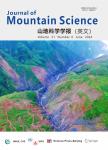Application of different clustering approaches to hydroclimatological catchment regionalization in mountainous regions, a case study in Utah State
Application of different clustering approaches to hydroclimatological catchment regionalization in mountainous regions, a case study in Utah State作者机构:Department of Water Resources Engineering Faculty of Civil Engineering University of Tabriz Department of Civil Engineering Near East University Department of Electrical and Electronic Engineering Near East University
出 版 物:《Journal of Mountain Science》 (山地科学学报(英文))
年 卷 期:2018年第15卷第3期
页 面:461-484页
核心收录:
学科分类:0709[理学-地质学] 0819[工学-矿业工程] 08[工学] 0303[法学-社会学] 0708[理学-地球物理学] 0818[工学-地质资源与地质工程] 081501[工学-水文学及水资源] 0705[理学-地理学] 0815[工学-水利工程] 0706[理学-大气科学] 0816[工学-测绘科学与技术] 0813[工学-建筑学] 0704[理学-天文学] 0833[工学-城乡规划学] 0713[理学-生态学] 0834[工学-风景园林学(可授工学、农学学位)]
主 题:Catchment clustering K-means Ward Self-Organized Map Wavelet–Entropy Utah
摘 要:With respect to the different hydrological responses of catchments, even the adjacent ones, in mountainous regions, there are a great number of motivations for classifying them into homogeneous clusters. These motivations include prediction in ungauged basins(PUB), model parameterization, understanding the potential impact of environmental changes, transferring information from gauged catchments to the ungauged ones. The present study investigated the similarity of catchments through the hydro-climatological pure time-series of a 14-year period from 2001 to 2015. Data sets encompass more than 13,000 month-station streamflow, rainfall, and temperature data obtained from 27 catchments in Utah State as one of the eight mountainous states of the USA. The identification, analysis, and interpretation of homogeneous catchments were investigated by applying the four approaches ofclustering, K-means, Ward, and SOM(Self-Organized Map) and a newly proposed Wavelet-Entropy-based(WE-SOM) clustering method. By using two clustering evaluation criteria, 3, 5, and 6 clusters were determined as the best numbers of clusters, depending on the method employed, where each cluster represents different hydro-climatological behaviors. Despite the absence of geographic characteristics in input data matrix, the results indicated a regionalization in agreement with topographic characteristics. Considering the dependency of the hydrological behavior of catchments on the physiographic field aspects and characteristics, WE-SOM method demonstrated a more acceptable performance, compared to the other three conventional clustering methods, by providing more clusters. WE-SOM appears to be a promising approach in catchment clustering. It preserves the topological structure of data which can, as a result, be proofed in a greater number of clusters by dividing data into higher numbers of distinct clusters withsimilar altitudes of catchments in each cluster. The results showed the aptitude of wavelets to



